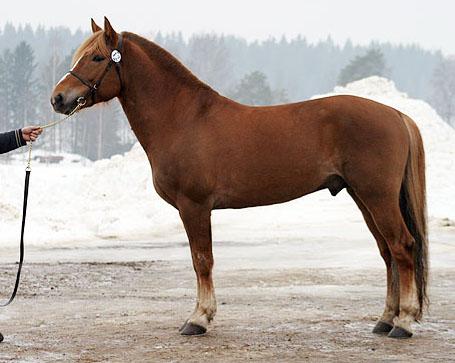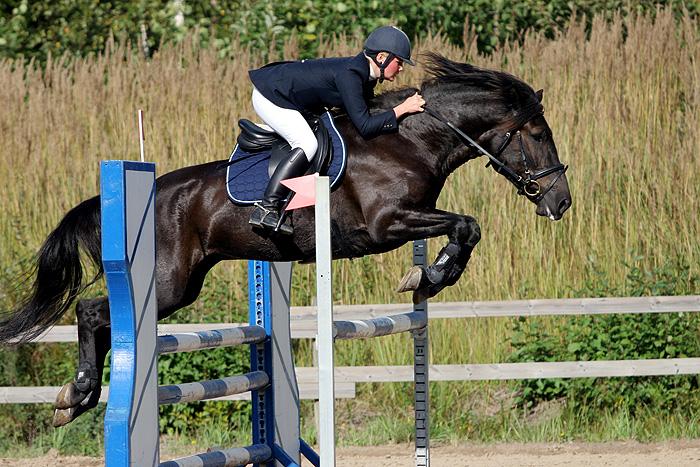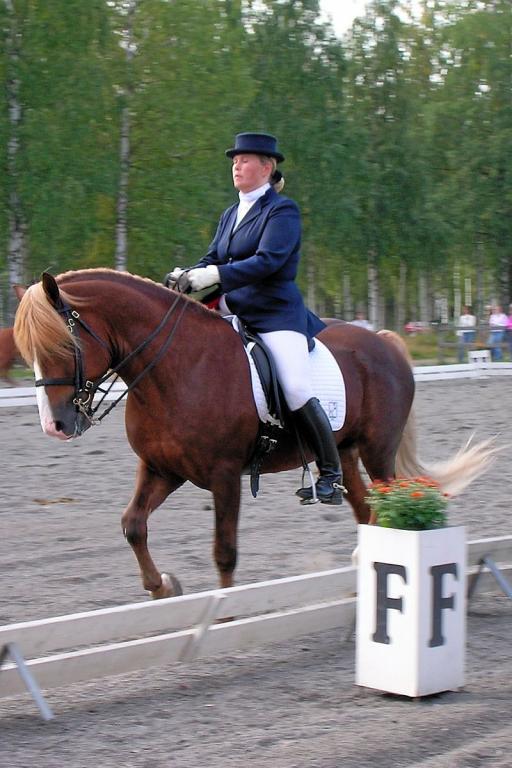
Continent: Europe
Country: Finland
Weight: 420 – 450 kg
Height: 135 – 147 cm


The Suomenhevonen, also known as the Finnhorse, is the only native horse breed of Finland. Its origins date back several centuries, descending from indigenous horses present since the Middle Ages in the country’s rural and forested regions.
It was initially developed in the southern and central areas of Finland, particularly around Häme, Savo, Ostrobothnia, and Karelia. These regions, characterized by harsh climates and demanding landscapes, contributed to shaping a horse that is rustic, hardy, and extremely versatile.
A symbol of Finnish culture :
The Suomenhevonen is a powerful national symbol and represents an essential part of Finland’s rural identity. It played a central role in daily life, especially through:
– agricultural work, in fields and forests,
– transportation, by cart or sleigh,
– military service, particularly during the wars of independence and 20th-century conflicts,
– harness racing, which became a national passion.
The breed is also widely represented in Finnish literature, folk art, and rural celebrations, where it symbolizes peasant pride, the Nordic spirit, and resilience.
Finnhorse breeding is spread throughout Finland, though some historic and agricultural regions remain key breeding hubs.
Main breeding zones:
– Häme (Tavastia) – South-central Finland
Traditional breeding region with numerous farms. High level of professionalism in reproduction.
– Savo (Northern and Southern Savonia)
Forested area where Finnhorses were historically used for logging and hauling. Rustic bloodlines adapted to difficult terrain.
– Pohjanmaa (Ostrobothnia)
Large agricultural plains ideal for draft horse breeding. Many family-run farms combining mixed agriculture and horse breeding.
– Pirkanmaa & Keski-Suomi (Central Finland)
Strong development of leisure riding and driving disciplines. Includes training centers for riding and harness horses.
– Uusimaa (Helsinki region)
Smaller breeding activity but important for urban leisure and competition use.
Finnhorses are raised nationwide, from densely populated southern regions to remote northern rural areas.
The breeding network is supported by local cooperatives, regional studbooks, and central oversight by Suomen Hippos ry.
They are also present in the Åland Islands, where a few breeders contribute to the breed’s conservation.
The Suomenhevonen, or Finnhorse, holds major genetic importance as a unique and isolated national breed. Its value lies as much in its preserved genetic integrity as in its functional versatility, shaped by over a century of rigorous selective breeding.
Key aspects of its genetic value:
– Closed studbook since 1907: No crossbreeding is allowed, making the Finnhorse a genetically homogeneous and distinct population, rare on a European scale.
– Adaptation to northern climates: It carries genes that grant excellent resistance to cold, harsh terrain, and demanding working conditions.
– Genetic versatility: Divergent selection within a single genetic base has produced four types (draft, trotter, riding, harness), without losing breed cohesion.
– Limited but monitored gene pool: Finnish authorities (Suomen Hippos) conduct strict genetic diversity monitoring via DNA and pedigrees, to limit inbreeding.
– Heritage conservation: Listed as a heritage breed within Nordic animal biodiversity conservation programs (NordGen), the Finnhorse is a unique genetic reservoir in Northern Europe.
Potential contribution:
The breed could be useful in targeted crossbreeding programs aiming to improve hardiness, fertility, calm temperament, and versatility in local or endangered breeds.
In summary, the Finnhorse is both a national genetic treasure for Finland and a strategic resource for equine biodiversity conservation in northern climates.
Ancient origins (before 1800):
The first horses in Finland date back to medieval times, descending from rugged Scandinavian populations.
Over the centuries, these native horses were shaped by natural selection under the harsh northern climate: forests, lakes, swamps, and harsh winters.
The original type was small, hardy, resilient, and frugal, used for agricultural work, draft, and warfare.
Beginning of organized breeding (1800–1907):
In the 19th century, faced with the growing need for draft and war horses, attempts were made to cross local horses with foreign breeds (Friesian, Norwegian, Russian Trotter), with mixed results.
Toward the end of the century, national awareness emerged, along with the desire to preserve a purely Finnish breed.
Foundation of the studbook (1907):
In 1907, the Finnish government created a closed national studbook, officially establishing the Suomenhevonen breed.
All horses had to descend from registered Finnish breeding stock foreign crossbreeding was prohibited, ensuring strict genetic purity.
The standard defined a versatile horse, suitable for draft work, riding, and military transport.
War and reconstruction (1917–1945):
The Suomenhevonen played a crucial role during Finland’s War of Independence (1917) and the Winter War and Continuation War against the USSR.
Thousands of horses were mobilized for military logistics, ambulance transport, hauling artillery, etc.
After the wars, the breed became essential to post-war agricultural reconstruction.
Specialization and diversification (1950–1980):
With mechanization, horse populations declined sharply in the 1950s–60s.
To prevent extinction, the studbook was divided into four sections:
– Draft
– Trotter (racing)
– Riding
– Driving
This allowed the breed to adapt to modern society while preserving its unique genetic base.
Heritage revival and valorization (1980–today):
From the 1980s onward, the Suomenhevonen experienced a cultural and sporting revival.
It became a national symbol, celebrated in festivals, museums, and folk art.
Today, it participates in trotting competitions, leisure riding, sport driving, and educational activities.
It is recognized as an endangered breed to preserve at the Nordic level by NordGen.
The Suomenhevonen is renowned for its balanced temperament, willingness to work, and docility, making it a favorite among both professionals and amateur riders.
Key behavioral traits:
– Calm and reliable: The Suomenhevonen is generally composed, tolerant to noise and unfamiliar environments, making it ideal for beginners, children, and therapeutic activities.
– Willing and hardworking: It has a strong work ethic, inherited from its agricultural and military origins. It is never reluctant to perform tasks or make efforts.
– Intelligent and responsive: It learns quickly, understands instructions easily, and has a good memory — qualities that are useful in driving, dressage, or trail riding.
– Respectful and social: It builds trusting relationships with humans and cooperates willingly. It is rarely aggressive and integrates well into a herd.
– Energetic but manageable: While it can have energy, especially in the trotter or riding types, it remains easy to control and balanced, even for intermediate riders.
Behavioral variation by type:
– Draft type: calm, strong, unemotional
– Trotter type: more nervous, lively, competitive
– Riding type: dynamic, supple, responsive
– Driving type: enduring, disciplined, attentive
In summary, the Suomenhevonen’s character combines the quiet strength of a northern rustic breed with a natural willingness to cooperate, making it a reliable, intelligent, and versatile partner.
The future of the Finnhorse is both promising and strategically managed, within a context of breeding modernization, heritage valorization, and usage diversification.
Positive trends:
– Protected national breed: The Finnhorse enjoys strong institutional support in Finland. It is promoted as living heritage and part of genetic conservation policies (NordGen).
– Expanding versatility: Its adaptability to various uses (sport, leisure, driving, racing, work) ensures continued relevance in an evolving equine world.
– Improved selection methods: Advances in genomics, performance testing, and indexing enable precise selection within its four official lines.
– Growing international interest: While mostly bred in Finland, the breed is increasingly recognized abroad for its hardiness, mental strength, and robustness.
Challenges ahead:
– Limited gene pool: As a closed breed, maintaining genetic diversity is critical, particularly within specialized lines.
– Competition from foreign breeds: In disciplines like jumping and dressage, it is often overshadowed by high-performance warmbloods, limiting investment from young riders.
– Aging breeder population: A generational renewal is needed to sustain population levels and traditional knowledge transfer.
Long-term prospects:
– Positioned as a sustainable Nordic leisure horse, eco-friendly, low-maintenance, and suited to modern equestrian practices (trail riding, competitive driving, animal-assisted therapy).
– Promotion of national equestrian tourism with the Finnhorse as a cultural symbol.
– Controlled internationalization possible in Nordic or Baltic countries with similar climates.
In summary, the breed has strong assets for long-term survival, as long as it balances tradition and innovation, and maintains vigilant genetic management.
The Suomenhevonen is a breed renowned for its natural hardiness, longevity, and strong disease resistance qualities shaped by centuries of adaptation to Finland’s harsh climate.
Health strengths:
– Exceptional hardiness: Well adapted to cold weather, it tolerates long, damp winters without needing artificially protected living conditions.
– Good longevity: Many individuals live and remain active up to 25 years or more.
– Strong immune system: Rarely affected by common infections (equine influenza, mange, etc.), especially when raised in a healthy and natural environment.
– Resilient hooves: Hooves are strong and healthy, seldom prone to rot or hoof diseases, occasionally allowing for barefoot use.
Points of concern:
– Tendency to gain weight: Due to its efficient metabolism, it can easily become overweight if overfed or underworked.
– Joint issues: Some lines particularly those bred for draft work or racing may be prone to joint disorders or premature wear under intensive use.
– Inbreeding control: As a closed stud-book breed, maintaining genetic diversity is critical to avoiding hereditary diseases. DNA testing is systematically used in selection programs.
Veterinary monitoring in Finland:
The breed is closely monitored by Suomen Hippos ry, with strict protocols for breeding, identification, and health control.
Veterinary examinations are mandatory for horses applying to enter the breeding stud-book.
In summary, the Suomenhevonen is generally a very healthy, low-maintenance horse, well-suited to natural conditions, provided its diet and exercise are properly managed.
Born on 01/01/1912
– One of the founding stallions of the trotting line in the Suomenhevonen studbook.
– Highly influential in today’s trotting genetics: many Finnish racehorses trace their lineage back to Murto.
– Founder of the Murto sire line, which is still active today.
Born on 01/01/1920
– A versatile working stallion, highly respected in agricultural regions.
– Gave his name to one of the four main paternal lines of the Suomenhevonen.
– Embodied the ideal farm horse: strong, docile, and reliable.
Born on 01/01/1989
– The most famous Finnish trotter of all time.
– Ran 141 races, placing in the top three 135 times – an outstanding record.
– Winner of multiple major Scandinavian trotting events, with a personal record of 1:19.9/km, an exceptional time for a Finnhorse.
– Became a highly sought-after stallion, leaving a profound impact on the trotting line.
– Considered a national hero in Finland, widely celebrated in the Finnish media.